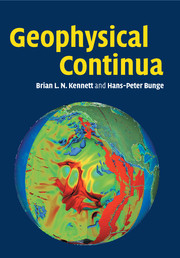Book contents
- Frontmatter
- Contents
- Preface
- 1 Introduction
- PART I CONTINUUM MECHANICS IN GEOPHYSICS
- PART II EARTH DEFORMATION
- 9 From the Atomic Scale to the Continuum
- 10 Geological Deformation
- 11 Seismology and Earth Structure
- 12 Lithospheric Deformation
- 13 The Influence of Rheology: Asthenosphere to the Deep Mantle
- 14 Mantle Convection
- 15 The Core and the Earth's Dynamo
- Appendix: Table of Notation
- Bibliography
- Index
10 - Geological Deformation
from PART II - EARTH DEFORMATION
Published online by Cambridge University Press: 17 March 2011
- Frontmatter
- Contents
- Preface
- 1 Introduction
- PART I CONTINUUM MECHANICS IN GEOPHYSICS
- PART II EARTH DEFORMATION
- 9 From the Atomic Scale to the Continuum
- 10 Geological Deformation
- 11 Seismology and Earth Structure
- 12 Lithospheric Deformation
- 13 The Influence of Rheology: Asthenosphere to the Deep Mantle
- 14 Mantle Convection
- 15 The Core and the Earth's Dynamo
- Appendix: Table of Notation
- Bibliography
- Index
Summary
In Part I we have concentrated on materials which in the aggregate, at least, have relatively simple properties and focussed on the impact of the latest phase of deformation. These concepts are of considerable utility in understanding the nature of evolution of structure in rocks, but we have to take into consideration the nature of the complex mineralogical composites whose properties depend strongly on physical conditions.
We have abundant evidence of past deformation in rocks on many length scales. The structures that are seen both in the fine scale microfabric and on much larger scales in field exposures frequently reflect the influence of multiple phases of deformation and spatially varying strain.
Different classes of rocks have a wide range of chemical and mineralogical compositions, which have experienced physical and chemical environments that themselves may have shaped the actual fabric. Rock masses contain materials with a large variation in strength, determined by local mineralogy, which respond in very different ways to the same stress field, leading to differences in local strain. Further, the specific temperature and pressure conditions due, e.g., to depth of burial will affect the way in which the rock units behave.
The action of the stress system will lead to a pattern of deformation that will vary from point to point as parts of the body move relative to each other, in part because of the differences in mechanical properties of the different parts of the rock mass.
- Type
- Chapter
- Information
- Geophysical ContinuaDeformation in the Earth's Interior, pp. 180 - 206Publisher: Cambridge University PressPrint publication year: 2008



